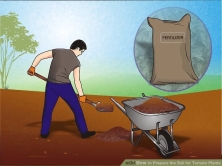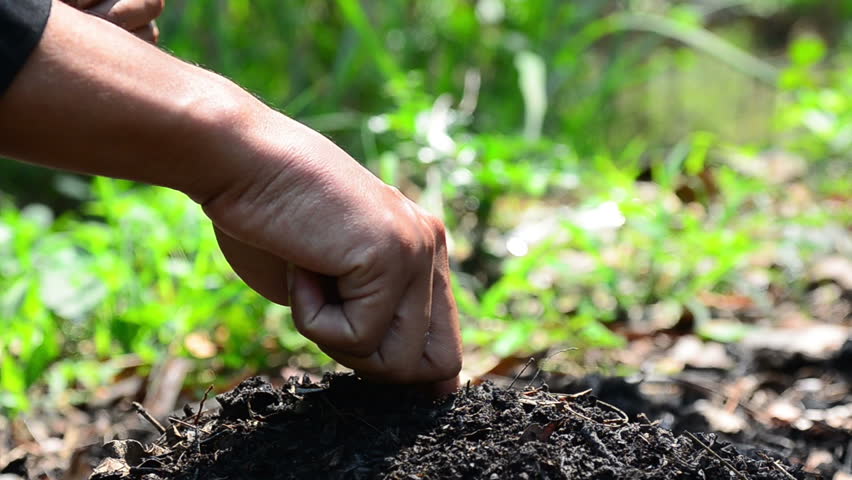I’ve been working with a student who’s been dealing with much self-doubt and anxiety, so much so, it’s been paralyzing and debilitating to his ability to fulfill simple tasks. What has been very helpful is the metaphor of training the mind as the practice of cultivating our “mind’s garden” or as the Chinese called it: the Mind-Ground* (心地, Hsin-Ti).
In any task, from the most mundane – such as doing a work assignment or preparing dinner – to the highest of pursuits, like cultivating realization and liberation, we can never predict the outcome. Because of being completely habituated to worrying, we may feel to an extent that the anxiety and stress we feel are motivating us, and that without these emotions we might forget everything and not succeed at our task. Although, with any amount of reflection we can see clearly that this is a false assumption.
Let us take the metaphor of a garden. Let’s say we want to plant tomatoes.
 We prepare the soil, supplement with compost, throw in some seeds, cover them carefully. We have fulfilled the “setting out” stage of the task. We took the first step.
We prepare the soil, supplement with compost, throw in some seeds, cover them carefully. We have fulfilled the “setting out” stage of the task. We took the first step.
Now, as we know, we must water the seedling and when needed, fertilize it. We need to check in and see what’s going on with it regularly. This is the second stage of “seeing through”.
After a while, we see signs of pests or a disease. We need to control the pests, preferably by using nonviolent, organic methods. We may need to adjust the pH of the soil, and apply a liming material. This is “adjusting to circumstances”, the third stage.
 We may see that there are weeds in the garden taking over our tomato patch. We will then need to take care of those by removing them and throwing them in with the compost. This is the fourth stage – “Removing negative influence”.
We may see that there are weeds in the garden taking over our tomato patch. We will then need to take care of those by removing them and throwing them in with the compost. This is the fourth stage – “Removing negative influence”.
Now, at the end of this process we might get our tomatoes, or we might not. For simplicity’s sake let’s say that if we follow the instructions, there’s a 50% chance of success. However if we don’t follow the instructions or if we decide to not even do it because we think, “but I might not even get any tomatoes at the end!”, we end up with an absolute certainty of failure. There’s a 99.9% chance (barring coincidence) that no tomatoes will come.
As you see, stress and anxiety, or in this case – standing there and screaming at the seedlings, “why won’t you damn things grow already?!”, has no part in the process. We can do only two things. Decide and act. Not thinking about the end result is what in Buddhism is called “not attaching to the fruit”.
This is very important- Thinking about what might or might not happen as a result of your labor is completely superfluous. It adds nothing. All you can do is decide you want to do something and then follow the instructions on how to do it. If you’re unsure you’re doing it right, there’s only one thing you can do: ask for help.
Sometimes, you’re going to need a seasoned gardener to take a look at your labor. This is someone who’s grown hundreds of successful tomato crops and can let you know how you’re doing. Sometimes you’ll be able to google your way out of a situation, but 9 times out of 10 you’re better off asking a veteran.
So let’s summarize:
- Set out by deciding what you want to do, thus planting the seed in your mind-ground.
- See it through, by following the instructions that you have on how to best fulfill your task.
- Adjust to circumstances, by checking in as you’re working to see if there’s anything in your process that calls for course-correction.
- Remove negative influence, by getting rid of any part of the process that you recognize to be damaging to it.
Throughout this process, from start to end, remember the two cardinal rules:
A. Do not attach to the fruits. Forget about the outcome, you can’t do anything more about it.
B. When in doubt, consult an expert. Ask for help from someone who’s done this before.
That’s it, your 50% tomatoes are complete. Enjoy each bite!
*Hsin-Ti (Mind-Ground) was explained by Tan’g Dynasty Master Huai-Jang thus:
“You should understand the doctrine of the mind-ground, which teaches that this mind-ground is as if planted with seeds. When I expound the essentials of the Dharma to you, it will be like rain falling upon that ground. Because the circumstances of your make-up join with the rain, therefore you are able to see the Way.”
Image Credits: WikiHow
If you enjoy the content on this website, consider supporting us by going here: Support Us. Without your help, we wouldn’t be able to do this work. Thank you!

I make inspirational tiles. I’m adding “Decide and Act!” to my list of tiles to make!
This was a great reading.
Thank you.
LikeLiked by 1 person